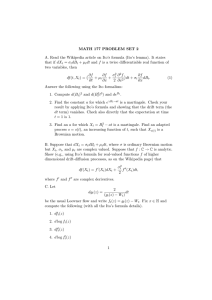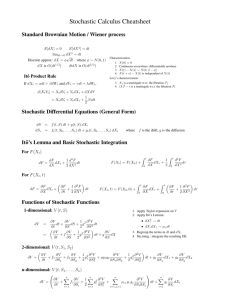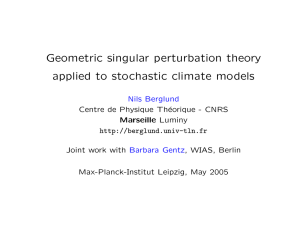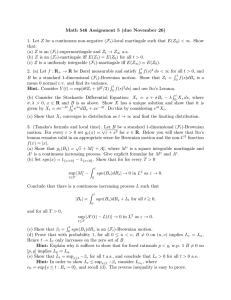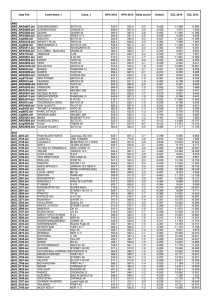MAT4701: Voluntary Assignment 2
advertisement
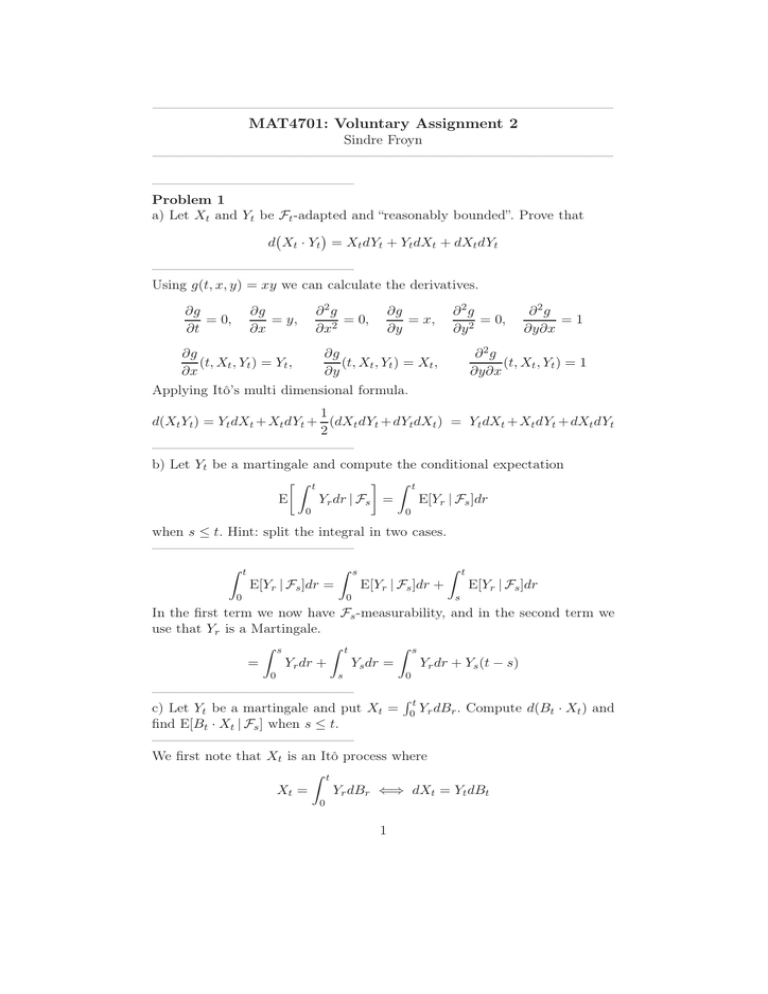
—————————————————————————————————
MAT4701: Voluntary Assignment 2
Sindre Froyn
—————————————————————————————————
——————————————–
Problem 1
a) Let Xt and Yt be Ft -adapted and “reasonably bounded”. Prove that
d Xt · Yt = Xt dYt + Yt dXt + dXt dYt
——————————————–
Using g(t, x, y) = xy we can calculate the derivatives.
∂2g
= 0,
∂x2
∂g
= y,
∂x
∂g
= 0,
∂t
∂g
= x,
∂y
∂2g
= 0,
∂y 2
∂2g
=1
∂y∂x
∂2g
(t, Xt , Yt ) = 1
∂y∂x
∂g
∂g
(t, Xt , Yt ) = Yt ,
(t, Xt , Yt ) = Xt ,
∂x
∂y
Applying Itô’s multi dimensional formula.
1
d(Xt Yt ) = Yt dXt + Xt dYt + (dXt dYt + dYt dXt ) = Yt dXt + Xt dYt + dXt dYt
2
——————————————–
b) Let Yt be a martingale and compute the conditional expectation
Z t
Z t
Yr dr | Fs =
E
E[Yr | Fs ]dr
0
0
when s ≤ t. Hint: split the integral in two cases.
——————————————–
Z t
Z s
Z t
E[Yr | Fs ]dr
E[Yr | Fs ]dr +
E[Yr | Fs ]dr =
0
0
s
In the first term we now have Fs -measurability, and in the second term we
use that Yr is a Martingale.
Z s
Z t
Z s
=
Yr dr +
Ys dr =
Yr dr + Ys (t − s)
0
0
s
——————————————–
Rt
c) Let Yt be a martingale and put Xt = 0 Yr dBr . Compute d(Bt · Xt ) and
find E[Bt · Xt | Fs ] when s ≤ t.
——————————————–
We first note that Xt is an Itô process where
Z t
Yr dBr ⇐⇒ dXt = Yt dBt
Xt =
0
1
Using the result from a), we know that
d(Bt Xt ) = Xt dBt + Bt dXt + dBt dXt
Substituting Yt dBt for dXt and using that dBt2 = dt.
= Xt dBt + Bt Yt dBt + Yt dt = Yt dt + Xt + Bt Yt dBt
Writing in integral form with B0 X0 = 0 since B0 = 0.
Z t
Z t
(Xr + Br Yr )dBr
Yr dr +
Bt Xt =
0
0
Taking the conditional expectation.
hZ t
i
hZ t
i
E[Bt Xt | Fs ] = E
(Xr + Br Yr )dBr | Fs
Yr dr | Fs + E
0
0
The first term was calculated in b), and the second term is a pure stochastic
integral which means it is a martingale:
Z s
Z s
(Xr + Br Yr )dBr
Yr dr + Ys (t − s) +
=
0
0
——————————————–
Problem 2
a) Let σ(t, ω) be any bounded Ft -adapted stochastic process. Solve the initial
value problem
dXt = −2tXt dt + σ(t, ω)
X0 = 1
and compute E[Xt ]. Xt and Bt are 1-dimensional.
——————————————–
2
Introducing the integrating factor et .
2
2
2
d(et Xt ) = 2tet Xt dt + et dXt =
2
2
2tet Xt dt + et
2
− 2tXt dt + σ(t, ω) =
(
((2 ((
2
2
t (((
2te
Xt dt − 2tet Xt dt + et σ(t, ω) = et σ(t, ω)
((
(
Writing in the integral form, and recalling that X0 = 1.
Z t
2
t2
es σ(s, ω)dBs
e Xt = X0 +
0
Z
2
Xt = X0 e−t +
t
es
2 −t2
σ(s, ω)dBs
0
−t2
Xt = e
+
Z
t
es
0
2
2 −t2
σ(s, ω)dBs
Taking the expectation:
h
2
E[Xt ] = E e−t ] + E
Z
t
es
0
2 −t2
i
2
σ(t, ω)dBs = e−t
2
since e−t is a constant and the expectation to a stochastic integral is 0.
——————————————–
b) Consider the 1-dimensional initial value problem
dXt = b(t, Xt )dt + σ(t, Xt )dBt
X0 = x
Spell out in detail what conditions on b and σ are needed for a unique solution
to exist.
——————————————–
As per theorem 5.2.1 from the text book.
|b(t, x) − b(t, y)| ≤ C|x − y|
|σ(t, x) − σ(t, y)| ≤ C|x − y|
|b(t, x)| ≤ C(1 + |x|)
|σ(t, x)| ≤ C(1 + |x|)
Both b and σ need to be Lipschitz continuous and they can have at most
linear growth. The uniqueness is dependant on the Lipschitz property. Also
E[|x|2 ] < ∞.
——————————————–
In the rest if thus problem we will assume that b : [0, ∞) → R is a continuous
function (note: no dependence on ω in b). We further assume that the
coefficients in the initial value problem
dXt = b(t) · Xt dt + σ(Xt )dBt
X0 = x
satisfy the conditions spelled out in b).
c) Find Ex [Xt ].
——————————————–
We begin by solving the SDE, and do so by multiplying with
R t the integrating
−B(t)
′
factor e
where B (t) = b(t), or equivalently B(t) = 0 b(s)ds.
d e−B(t) Xt = −b(t)e−B(t) Xt dt + e−B(t) dXt =
−b(t)e−B(t) Xt dt + e−B(t) b(t)Xt dt + σ(Xt )dBt = e−B(t) σ(Xt )dBt =⇒
Z t
−B(t)
e−B(s) σ(Xs )dBs
e
Xt = X0 +
0
Xt = xeB(t) +
Z
t
eB(t)−B(s) σ(Xs )dBs
0
Taking the expectation,
Ex [Xt ] = xeB(t)
3
——————————————–
d) Let h > 0 and assume that Xh (ω) is known. Compute Ex [Xt+h |Fh ].
——————————————–
By the Markov property, and using that f (x) = x,
Ex [f (Xt+h ) | Fh ] = EXh [f (Xt )] = Ex [Xt ]x=Xh
By the result in c),
= Xh eB(t)
——————————————–
Rt
e) Prove that Yt = Xt · e− 0 b(s)ds is a martingale.
——————————————–
Rt
We’ll use B(t) = 0 b(s)ds, so
Z t
−B(t)
e−B(s) σ(Xs )dBs .
Yt = Xt e
=x+
0
There are three properties we must verify. First Yt must be Ft -measurable.
This is trivial as we don’t use information from the future. Secondly Yt must
be finite, which follows from the assumptions we have on σ(Xs ) given in this
exercise. Thirdly E[Yt | Fu ] = Yu for u ≤ t. This point needs some special
consideration.
Z t
i
h
e−B(s) σ(Xs )dBs | Fu =
E[Yt | Fu ] = E x +
0
x+E
hZ
u
−B(s)
e
i
σ(Xs )dBs | Fu + E
0
hZ
u
t
i
e−B(s) σ(Xs )dBs | Fu =
By measurability and independence,
Z u
i
hZ t
−B(s)
e
σ(Xs )dBs + E
e−B(s) σ(Xs )dBs =
x+
0
u
since expected stochastic integrals are 0,
Z u
e−B(s) σ(Xs )dBs = Yu .
x+
0
The three properties are satsified, and Yt is a martingale.
——————————————–
Problem 3
Consider the initial value problem
p
X0 = x
dXt = rXt dt + |Xt |dBt
The coefficients in this equation do not satisfy the usual conditions for a
unique solution to exist. Which condition fails? Prove your statement.
——————————————–
4
The stochastic part σ(Xt ) does not satisfy the Lipschitz property. To
show this, we first see where the property is satisfied (as in equation 7.1.5 in
the text book).
σ(x) − σ(y) ≤ C|x − y|
p p
|x| − |y| ≤ C|x − y|.
p
p
If we define a = |x| ≥ 0 and b = |y| ≥ 0, we get a2 = x ≥ 0 and
b2 = y ≥ 0
|a − b| ≤ C|a2 − b2 | = C (a + b)(a − b) = C(a + b)|a − b| =⇒
1
≤ (a + b)
C
However, when we have a fixed C and choose small enough a and b such that
1 ≤ C(a + b) =⇒
1
> (a + b)
C
the Lipschitz continuity is not satisfied, and we can’t guarantee uniqueness.
——————————————–
Problem 4
Let B1 and B2 be two independent Brownian motions, and let τD be the
first exit time of the diffusion dXt = (dB1 (t), dB2 (t)) from the unit ball
D = {x = (x1 , x2 ) | x21 + x22 < 1}. Compute E x [τD ] when starting from a
point inside D. Hint: Use the Dynkin’s formula on f (x1 , x2 ) = x21 + x22 .
——————————————–
Dynkin’s formula states that,
hZ τ
i
Ex [f (Xτ )] = f (x) + Ex
Af (Xs )ds .
0
We begin by finding the generator Af (Xs ), which is given by
Af (x) =
X
i
bi (x)
∂2f
1X
∂f
(σσ T )i,j (x)
+
.
∂xi 2
∂xi ∂xj
i,j
Calculating the partial derivatives for i = 1, 2.
∂f
= 2xi ,
∂xi
∂2f
= 2,
∂x2i
∂2f
= 0 (i 6= j).
∂xi ∂xj
From the diffusion dXt we see that bi = 0 and σi = 1 for i = 1, 2, so all the
first derivatives are cancelled and σiT = σi . This results in
Af (x) =
1
∂2f
1
1X 2
σi (x) 2 = (1)(2) + (1)(2) = 2
2
2
2
∂xi
i
5
Obviously Af (Xs ) = 2. Using τ = σk = min(k, τD ) and the function f we
have, when (x1 , x2 ) is the starting point in D,
h Z σk i
x
2
2
2
2
x
E [B1 (σk ) + B2 (σk )] = x1 + x2 + 2E
ds
0
1
1 − (x21 + x22 )
2
When k → ∞ we get τD = lim σk < ∞ and
Ex [σk ] ≤
Ex [τD ] =
1 − (x21 + x22 )
2
——————————————–
Problem 5
Let dXt = 3dt + 2dBt , Xs = x, t ≥ s.
a) Write down Lf (s, x) for the extended process Yt = (t, Xt ).
——————————————–
By definition, for some f ∈ C 2 ,
LX f (x) =
X
bi (x)
i
∂2f
1X
∂f
(σσ T )i,j (x)
+
∂xi 2
∂xi ∂xj
i,j
1
= b(x)f ′ (x) + σ 2 (x)f ′′ (x) = 3f ′ (x) + 2f ′′ (x).
2
For the extended process,
LY f (s, x) =
∂f
∂2f
∂f
+3
+2 2.
∂s
∂x
∂x
——————————————–
b) Consider the optimal stopping problem
Φ(s, x) = sup E(s,x) [e−2τ Xτ ].
τ ≥s
Assume that this problem has an exit region
D = {(s, x) | − ∞ < x < x0 }
and use the verification theorem to determine x0 and Φ(s, x).
——————————————–
By the verification theorem we have the requirement Lφ + f = Lφ = 0 (since
f is 0 in this case).
Lφ(s, x) =
∂φ
∂φ
∂2φ
+3
+2 2 =0
∂s
∂x
∂x
6
(from a)
If we assume a solution on the form φ(s, x) = e−2s ψ(x) we get:
Lφ(s, x) = −2e−2s ψ(x) + 3e−2s ψ ′ (x) + 2e−2s ψ ′′ (x) = 0
=⇒ −2ψ(x) + 3ψ ′ (x) + 2ψ ′′ (x) = 0
We have a standard second degree differential equation. Using the quadratic
formula we find the roots r1 = 21 and r2 = −2 and get
x
ψ(x) = C1 e 2 + C2 e−2x .
For x ∈ D we see that as x → −∞, C2 e−2x → ∞ when we require it to be
equal to zero, so C2 = 0. Since we need to have continuity at the border of
D, we have the additional requirement ψ(x0 ) = x0 .
ψ(x0 ) = C1 e
x0
2
= x0
C1 = x0 e−
⇒
x0
2
Since φ ∈ C 1 (G) in the verification theorem we can determine x0 .
φ(s, x) =
∂φ(s, x)
=
∂x
x0 x
e−2s x0 e− 2 e 2
e−2s x
−2s
e
x0 −
2 e
e−2s
x0
2
x
e2
if x ≤ x0
if x > x0
if x ≤ x0
if x > x0
Setting the derivatives equal in the point x = x0 , which is on the border of
D these must be equal, and we can determine x0 .
e−2s
x0 − x 0 x 0
e 2 e 2 = e−2s
2
⇒
x0 = 2
By the verification theorem
x
Φ(s, x) = 2e 2 −2s−1 .
——————————————–
c) Solve the problem in b) again using dXt = 2dBt , Xs = x, t ≥ s. Prove
that the exit region (the complement of D) is bigger than in b), and try to
give an intuitive explanation for this.
——————————————–
For this process the b functions are 0, so all the first derivatives disappear
from the function.
∂2φ
∂φ
+2 2
Lφ =
∂s
∂x
Assuming φ(s, x) = e−2s ψ(x):
−2e−2s ψ(x) + 2e−2s ψ ′′ (x) = 0
7
⇒
ψ ′′ (x) − ψ(x) = 0
Finding the solutions for x2 − 1 = 0 which is r1 = 1 and r2 = −1 we have
ψ(x) = C1 ex + C2 e−x = C1 ex
since C2 = 0 because the second term diverges when x → −∞. By continuity
we require ψ(x0 ) = C1 ex0 = x0 so C1 = x0 e−x0 .
We have established that
−2s
e
x0 e−x0 ex if x ≤ x0
φ(s, x) =
e−2s x
if x > x0
We differentiate and set these equal at the transitional point x0 so we can
determine what it is.
−2s
∂φ(s, x)
e
x0 e−x0 ex if x ≤ x0
=
e−2s
if x > x0
∂x
e−2s x0 e−x0 ex0 = e−2s
⇒
x0 = 1
By the verification theorem Φ(s, x) = ex−2s−1 . We have proved that the exit
region with x0 = 1, which is [1, ∞), is bigger than the exit region from b)
which is [2, ∞).
The difference between the exit regions depends on the term 2dt which is only
present in the process from b). This term provides us with a positive drift
that counters the possible negative effects of the stochastic term. Because of
this the process allows for a larger maximum stopping time.
8
